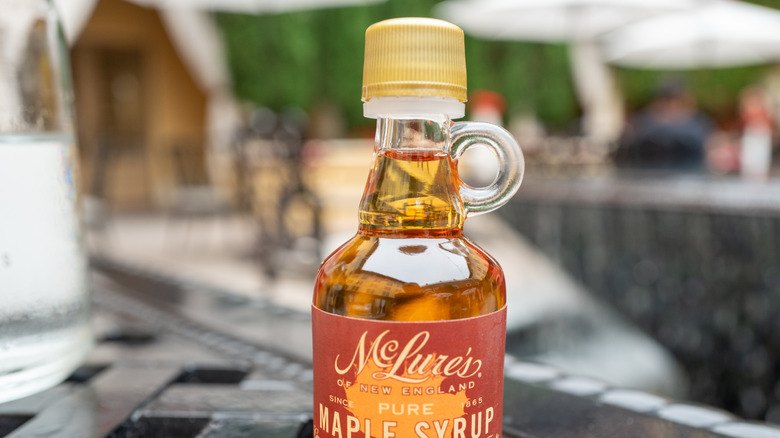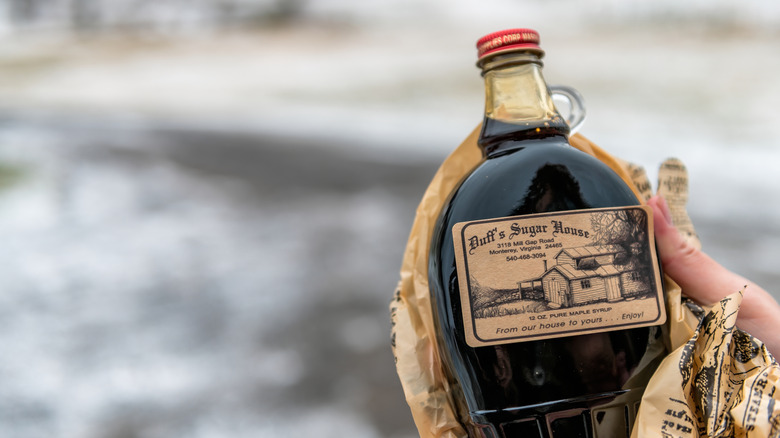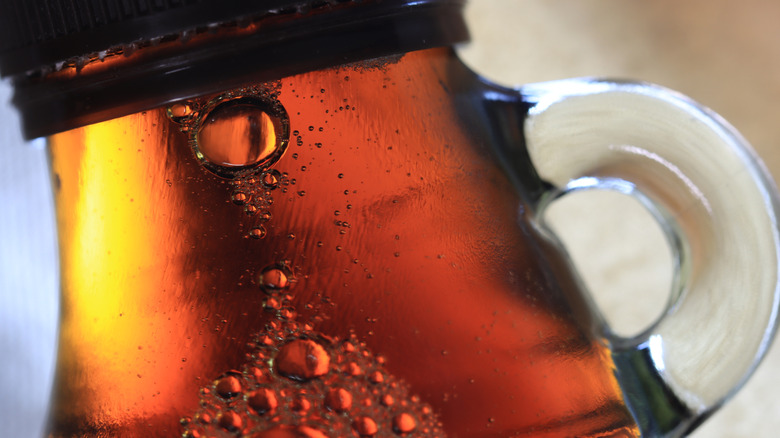Why Does Maple Syrup Have Tiny Handles?
Have you ever wondered why maple syrup bottles have those tiny handles? It's a common question that has both perplexed and intrigued Reddit users, bloggers, and everyone else in between for years. Contrary to the stout bottles filled with the delectable breakfast glaze in question, the answer isn't as short and sweet as you might think. While the classic maple syrup bottle offers an undoubtedly charming visual appeal, the handle isn't a world-changing invention. Affixed awkwardly to the neck of the typically oblong-shaped syrup bottle, it fails to serve a functional purpose at all (unlike the other everyday things you never knew the purpose of). With the average handle size too small to loop even the tiniest of fingers through, you're better off grasping the bottle around the middle and pouring away.
Believe it or not, there's a name for this type of non-functional feature: a skeuomorph. By definition, Merriam-Webster says a skeuomorph is "an ornament or design representing a utensil or implement." Other skeuomorph examples include electric candles, the shutter sound effect when you snap a picture on your phone, and car hubcaps designed to emulate the appearance of old-fashioned wagon wheels. Basically, anything that hearkens back to an earlier design but serves no physical purpose to the modernized design is a skeuomorph. This is the definition that comes in — well, handy — when it comes to explaining that tiny handle.
Getting a handle on the tiny handle
According to a Mental Floss article published in 2024, the tiny handle's classification as a skeuomorph is "the most widely accepted explanation" for its presence, connecting the modern maple syrup bottle to the giant ceramic jugs commonly used in the late 1800s. A blog post published by Brooklyn Brainery in 2012 also supports the skeuomorph theory, writing that the handles were used to carry large earthenware containers"the handles are a remnant from when jars typically larger and made of earthenware.
Meanwhile, a Reader's Digest Canada online article quotes a slightly differing explanation from Jean-François Lozier, a curator at the Canadian Museum of History. "Maple syrup companies weren't so much retaining an old pattern of a jug as reinventing it and wanting to market their product as something nostalgic," he said. Regardless of the reasoning behind the bottle design, the nostalgic element is evident.
The sticky history of the maple syrup bottle
If the tiny handle was intended to be a marketing tactic, it's proved to be a successful one. "Nowadays, through the magic of marketing and nostalgia, tiny handles = real maple syrup to all of us, and companies keep putting them on the bottle," Brooklyn Brainery pointed out. To uncover the origins of the grip, we have to go back to the mid-19th century.
In 1949, Brooks Fuerst, a glassware artist based in Toledo, Ohio (revered as the Glass Capital of the World), applied for a patent for his design — a flask-shaped vessel with a functionless handle attached to the neck. His patent, which he named "jug or the like," was adopted in 1950 by the Cary Maple Sugar Company. The Vermont-based business used the bottle to sell "Maple Maker," which allowed buyers to mix the maple-flavored syrup with hot water and sugar to create a larger quantity of syrup at a fraction of the price (arguably an invention that nobody asked for).
Though Fuerst is widely credited with the bottle design, he may not have been the first to come up with it. His older brother, Edwin Fuerst, secured a patent for a similar glassware design in 1933 named "design for a jug." The bottle was similar in shape to Brooks', only more rotund. Of course, the defining feature was the tiny, decorative handle on its neck.
Incidentally, the Cary Maple Syrup Company used the 1933 design to sell its syrup long before the "Maple Maker" was introduced. From here, the maple syrup lore only gets stickier. In 1922, years before the Fuerst brothers' designs, Joseph Klein was awarded a patent for his own, which was used for Little Brown Jug Syrup. It had a strikingly similar shape and (of course) that silly little handle.


